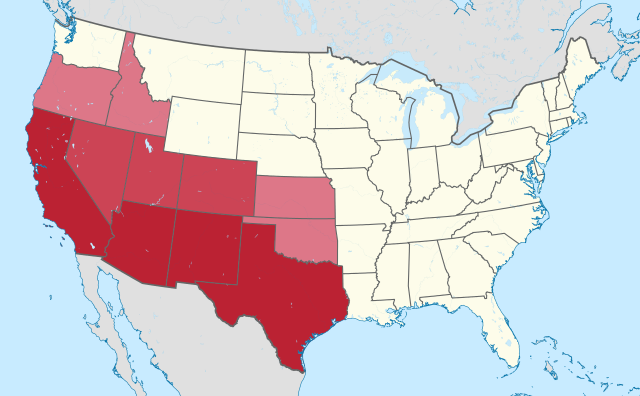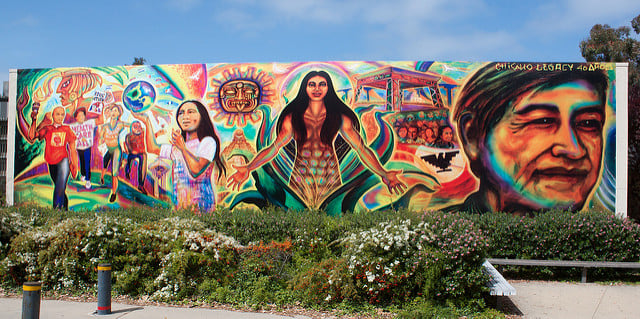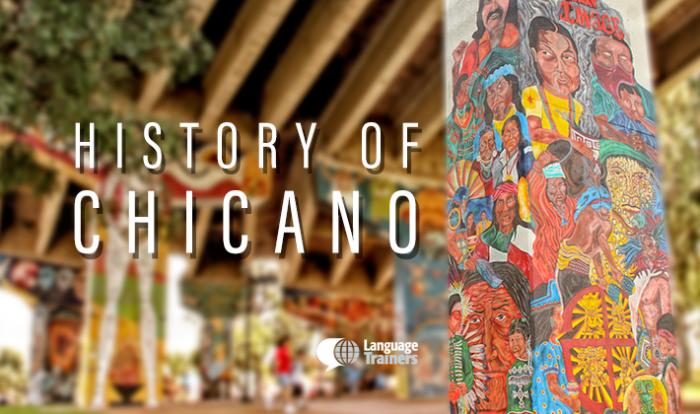Chicano History and Identity in the United States
If you live near the US-Mexican border, you may have heard the term “Chicano” used at least once in your life. But what exactly does it mean? Are Chicanos an ethnic group or are they a cultural movement? How did the ethnonym Chicano develop and how has Chicano history affected the development of Chicano activism? Join us as we teach you a little bit more about the Chicano identity in the United States and how it has been shaped over the past century.

Photo via Wikimedia
So who exactly is a Chicano?
As was first documented in 1911 by Texas anthropologist José Limón, Chicano refers to a mestizo (or a mixture) of about 60% European heritage and 30% indigenous heritage. There are quite a few hypotheses, but the main three are the following:
- Chicano or “Xicano” is interchangeably used out of respect to indigenous heritage because in the heydays of the Nahuatl people, who formed part of the Aztec tribe, the x or the sh sound was replaced by the conquistadores.
- Another hypothesis is that Chicano is derived from chilango, or someone from Mexico City or Central Mexico. Similarly, Chicano could have originated from the combination of Chicano and the Chichimecas, an indigenous tribe from Guanajauto.
- The third and most likely origin of Chicano, however, emerges out of the 1848 Treaty of Guadalupe Hidalgo, when 80,000 Spanish, Mexican, and Native Americans in the prosperous Rio Grande region (the current Southwest United States) were annexed to the United States after the Mexican-American War.
Due to the multiple hypotheses of the name’s origin, for most Mexican Americans, the ethnonym has distinctive meanings. From the beginning, Chicano was seen as a derogatory way to call Mexican migrants who were not Mexican enough nor American enough. Consequently, Chicano was rejected by many Mexican Americans throughout the Southwest in order to reject their Mexican heritage. Contrarily, others see it as a reference to Mexican-American pride. While a Chicano can appear to represent the mixture of a Mexican-American child, Mexican nationalists reject the separate Chicano identity because it leads to an even more separate Mexican-American identity.
Chicano Political and Social Activism: Past and Present
The Chicano movement was fundamentally created as a way to develop and increase Mexican-American pride and in turn help to establish equality in voting and political rights, farm workers’ rights, and improvement in education. Chicano relations saw a huge burst in support in the late 60s and 70s, with the help of César Chávez fighting for farmworkers’ rights with protests and a 25-day hunger strike. To be a Chicano in the 1970s represented a rebirth of the Mexican-American heritage and ushered in ethnic pride thus changing the negative connotation of derision.
Currently, Chicano relations have continued to grow while the Chicano movement’s firm grasp on artistic expression has grown and developed under the tutelage of Chicano artists and writers, who have created an environment of cultural expression in the theater, galleries, and cultural organizations.

Photo via Pinterest
Go on…
La Causa Chicana or the Chicana Renaissance stemmed from the 1960s and advanced through the use of ancestral themes and techniques. Later on, modern Chicano artists used murals and graphic art as a form of expression like the San Diego Chicano’s Park. Crusaders of the movement like Ruben Sálazar, a Mexican-American journalist who made it his duty to report the Chicano movement’s issues and demands, will not be forgotten in his fight for Chicano recognition. Even until Ruben’s alleged murder during the National Chicano Moratorium march in East Los Angeles 1970.
Feminist activists and playwrights like Cherrie Moraga, have been able to open the door to the Chicano culture as well as give an in-depth look into the LGBT community. Additionally Sandra Cisneros’ wrote, House on Mango Street which brought Chicano culture to the forefront to high-schoolers and middle-schoolers in the United States. In the music scene, the unforgettable skill of rock musicians such as Carlos Santana and Ritchie Valens, or rappers like Baby Bash and the creation of banda, a mixture of jazz, will forever have a Chicano imprint.
Chicano Future
Presently, the Chicano community in the United States is a strong voting block and will continue to grow in power as Latin American issues have resurfaced, such as immigration and education reform. As of now the Chicanos are an ethnic group that has inspired a movement, creating literary giants, artistic renditions, activism, and most importantly Mexican-American pride. Thus if one ethnic group could manage to taking a name and re-define it to inspire positivism and pride, Chicanos would the lead the way.

